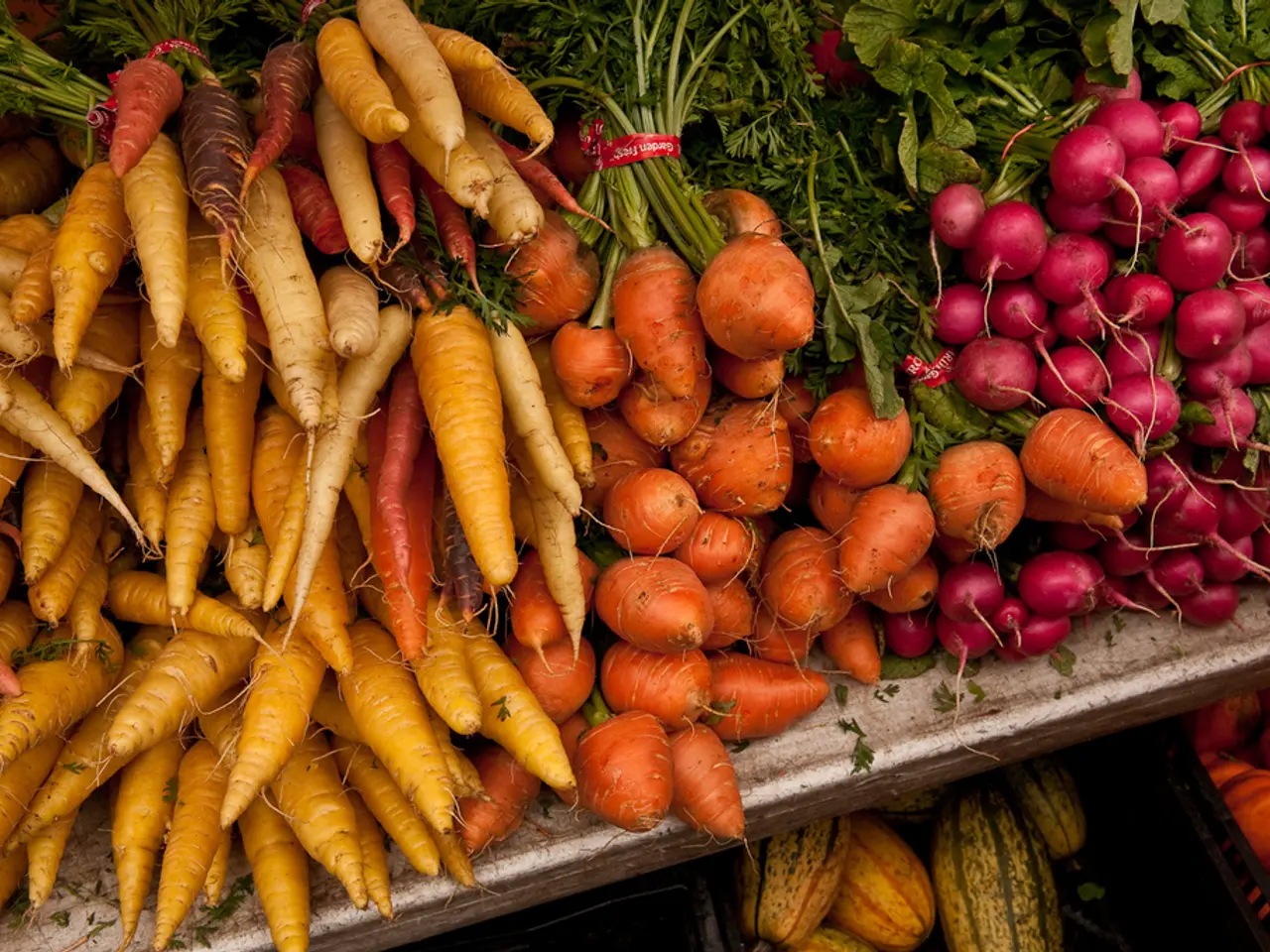Nine Vegetables to Sow in Your Garden During Autumn
Hey there, gardening enthusiast! As the lights dim and the weather cools, shake off the idea that it's time to park your gardening tools. The fall season opens up a whole new world of opportunities for growing a delicious, nutritious bounty in your vegetable garden. The cooler temperatures and shorter days are the sweet spot for many fall vegetables that love the chill and mature beautifully in these conditions. So grab a trowel, and let's dive into the nine magnificent vegetables you should consider planting in your fall garden.
Fall Delights for Your Garden
1. Tater Tots, Yes, Potatoes!
These versatile root subterranean warriors are excellent choices for your fall garden. Potatoes thrive in the cooler temperatures of fall and can be planted in mid to late summer for a harvest full of spuds by the first frost. Potatoes prefer a sun-kissed spot and loose, well-drained soil to grow into perfect tubers. As they grow, remember to keep them snuggled and protected from the sun's rays, mounding soil over the plants to avoid unpleasant green and bitter tubers.
Did you know? Potatoes were the very first edible plant grown in space! But don't worry; they aren't just fitting in on the ISS. They're a classic comfort food for all us earth-bound folks.
2. Beet, Beet, Goosey, Beet
Beets are a vibrant, bold, and nourishing fall vegetable, known for their deep red roots and earthy flavor. They can be planted in late summer, about 8-10 weeks before the first frost date. Beets fancy moist soil rich in organic matter and will grow best in full sun or partial shade. For continuous beet production, consider succession planting every two weeks.
Beet's family tree is scientifically fascinating (pun intended), as they're packed with nitrates, compounds that can positively affect athletic performance and help lower blood pressure. And don't forget their greens-they're powerhouses loaded with vitamins and minerals!
3. Brussels Sprouts as Small Cabbages
Brussels sprouts are part of the cabbage family, well-suited for cool weather. These tiny cabbages develop their best taste during fall and winter, as the cooler days help to reduce bitterness. Plant them in late summer for a fall harvest, and watch them transform from lush green sprouts into tasty morsels after the first frost.
Not only are they a classic fall crop, but Brussels sprouts are also nutritional powerhouses, high in fiber, vitamins C and K, and antioxidants. A great choice for your garden and your fall diet!
4. Arrogula, the Spicy Leafy Green
Arugula is a fast-growing, feisty leafy green that loves the cooler temperatures of fall. With its peppery flavor and tender leaves, arugula is perfect for salads and garnishes and is a cinch for beginner gardeners to grow. Sowing arugula is as easy as sprinkling seeds directly in the garden, and you can start enjoying leafy goodness as soon as three weeks after planting. Arugula prefers moist soil and partial shade, especially in warmer climates.
In addition to its spiciness, arugula is known for its anti-inflammatory properties. With nutrients like vitamins A, C, and K, arugula offers a healthy kick to your garden and your diet. For a continuous supply, try succession seeding every few weeks and make sure to harvest the leaves while they're still young and tender to avoid bitterness.
5. Captain Broccoli at the Helm
Broccoli is another member of the cabbage family that stands strong in fall's cooler temperatures. It can tolerate light frost and even improvements to its flavor. Plant broccoli in late summer or early fall, providing it with plenty of sun and fertile, well-drained soil for optimal growth. Broccoli requires consistent watering to develop its iconic nutritious centerpiece.
Broccoli is known as a "superfood" for good reason, as it's rich in vitamins, fiber, and antioxidants. It's particularly high in vitamin C, which helps support a strong immune system during the fall and winter months. Encourage a larger harvest by cutting the central head when it's fully developed to stimulate the plant to produce side shoots.
6. Carrots, Sweet Roots of Fall
Carrots are another cold-weather-loving root vegetable shining brightly in the fall. These sweety roots develop their most exquisite flavors in cooler temperatures, making them an excellent addition to your fall garden. To help carrot roots grow long and straight, plant them in loose, sandy soil and keep it consistently moist.
Fun fact: Did you know that before we started growing our bright orange carrots, they were purple or white? Carrots were the perfect color to hide in the dark dirt during the days of nighttime foraging! Carrots are also high in beta-carotene, which your body converts into vitamin A, supporting good vision and a powerful immune system. Dig up your carrots before the ground freezes, and store them in a cool, dry place for winter use.
7. Cauliflower, the Winter Prince
Cauliflower is a versatile fall vegetable from the cabbage family. It prefers cooler temperatures and does well in light frost, even improving its flavor in the process. Plant cauliflower in late summer or early fall, and give it plenty of sun and fertile, well-drained soil. Cauliflower needs consistent watering as the head grows, particularly during the formation of the familiar white head made up of tightly packed flower buds.
Beyond its versatility, cauliflower prides itself on its nutritional prowess. It is high in vitamins like vitamin C and K, as well as antioxidants, making it a smart choice for your fall diet. Did you know that cauliflower comes in colors beyond white, including purple, green, and orange, each with its unique set of nutrients? For example, the orange variety is high in beta-carotene, while the purple variety contains anthocyanins, powerful antioxidants. To ensure your cauliflower develops beautifully, cover it with its leaves or a cloth as it grows to protect it from the sun.
8. Winter Squash, Winter's Warm Embrace
Winter squash, including varieties like butternut, acorn, and spaghetti squash, is a hearty fall family member. These tubby treasures are planted in mid-to-late summer for fall harvest and need a long growing season to mature. Winter squash loves the sun and well-drained soil and appreciates regular watering throughout its growth process.
Winter squash isn't just delicious; it's also loaded with nutrients like vitamins A and C, fiber, and potassium. Plus, it stores well, making it an ideal choice for winter meals. Are you intrigued? Did you know that the seeds of winter squash are edible too? Roast them, and walah! You've got a healthy, crunchy snack.
9. Pumpkins, the Jack of All Trades
There's simply no fall garden complete without pumpkins! Pumpkins are perfect for carving, cooking, or decorating, and they're planted in mid-summer to be at their fiery best by October. Pumpkins crave the sun and well-drained soil and require plenty of space to grow and flourish.
Pumpkins are more than just Halloween decor. They are nutritional powerhouses, high in vitamins A and C, potassium, and fiber. Add them to your soups, pies, or smoothies, or roast their seeds for a healthy, crunchy snack. But make sure to harvest pumpkins before the first frost, and they'll keep you in a seasonal squashy mood for several months to come.
The Scoop
The magic of fall is upon us, and it's time to keep your green thumb afloat by extending your vegetable garden. Plant these nine fall vegetables, and fill your meals with delicious goodness that's ready to harvest when the days become shorter and the temperatures drop. Roast your Brussels sprouts, mash your potatoes, or carve your pumpkins, and let the flavors of fall warm your soul.
So what are you waiting for? Get out there and plant your heart out! Happy harvesting!
Please find enrichment data below for further exploration:
Enrichment Data
Overall:
The top 9 fall vegetables to plant in a garden, along with their benefits for a fall harvest, are:
- Lettuce
- Icy heart transmutes into succulent, crunchy leaves in cooler temperatures.
- Can grow in containers or raised beds, making them suitable for different garden setups.
- Wildly popular lettuce varieties for fall planting include 'Winter Density', 'Oakleaf', and 'Lollo Rosso'.
- Spinach
- Harvestable variety 'Space' is well-suited for fall planting, tolerating frost by going dormant and regrowing in spring.
- Provides early spring harvest potential, offering fresh, nutritious greens before other veggies are ready.
- Hardy spinach varieties like 'Bloomsdale' or 'Redman' are suitable for fall planting.
- Swiss Chard
- Adds color and interest to the fall garden with its rainbow stems and leaves.
- Continually produces leaves throughout the growing season when grown in appropriate conditions.
- 'Rainbow' chard, 'Ruby Red', and 'Fordhook Giant' are popular choices for fall gardens.
- Kale
- Varieties like 'Scarlet' and 'Lacinato' or 'Dinosaur' kale are bolt-resistant and suited for year-round growth.
- High in vitamins A, C, and K, kale is a nutritious and cold-hardy choice.
- Many chefs recommend blanching kale leaves before adding them to salads, as it improves texture and palatability.
- Onions
- Plant onion sets or seed in fall for delicious, tear-jerking onions come spring.
- 'Red Torpedo' and 'Walla Walla' are suitable for fall planting and maturing throughout winter.
- Lower soil temperatures triggered by frozen ground improve the flavor of stored onions.
- Garlic
- Fall planting of cloves results in a delicious, homegrown garlic harvest in July or early August of the following year.
- Varieties like 'Elephant', 'Inchelium Red', and 'Porcelain' are suitable for fall planting.
- Mature garlic cloves can be frozen for extended storage or air-cured for use in meals.
- Peas
- Fall-planted shelling peas or sugar snap peas can provide a petite treasure chest of protein-packed goodness before the first frost.
- Short-season varieties, such as 'Little Marvel' or 'Oregon Sugar Pod II', are suitable for fall planting.
- Quick-maturing peas may also help fix nitrogen in the soil, benefiting subsequent plantings in your fall garden.
- Leeks
- Milder in flavor than onions, leeks can be grown throughout fall and early winter in milder regions before the soil becomes too cold.
- Leeks appreciate loose, well-drained soil and proper watering to encourage strong leaf growth.
- 'Tadorna', 'King Richard', and 'Ozawa Wadaiko' are popular leek varieties suitable for fall planting.
- Garlic Chives
- Milder than traditional chives and able to tolerate colder temperatures, garlic chives make an excellent addition to fall gardens.
- Garlic chives serve as both an attractive ornamental plant and a tasty culinary herb.
- Complement soups and stir-fries with the unique garlic flavor of garlic chives as they grow throughout fall and winter.
- The cooler temperatures and shorter days of fall are perfect for growing leek, a mild vegetable that can be planted in late summer or early fall and appreciates loose, well-drained soil and proper watering to encourage strong leaf growth.
- After a successful harvest of autumn vegetables like carrots, potatoes, and Brussels sprouts, consider adding garlic chives to your garden. Milder than traditional chives, garlic chives are able to tolerate colder temperatures, making them an ideal choice for a home-and-garden lifestyle in the fall season.







